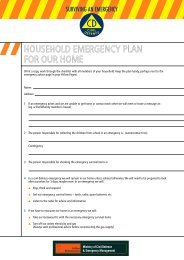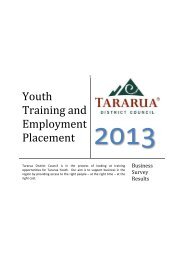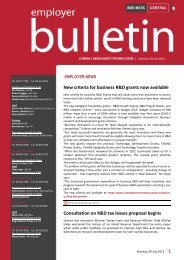Food Control Plan Checklist - Tararua District Council
Food Control Plan Checklist - Tararua District Council
Food Control Plan Checklist - Tararua District Council
- No tags were found...
You also want an ePaper? Increase the reach of your titles
YUMPU automatically turns print PDFs into web optimized ePapers that Google loves.
Serve SafePurchasing and receiving goods1 Goal 2 Why?To ensure ingredients and supplies are obtained fromreputable suppliers, and to check they are transportedappropriately and arrive in good condition.• <strong>Food</strong> may be contaminated with harmful microbes,chemicals or physical objects during processing or delivery.• Harmful microbes can grow if readily perishable food is notkept cold during delivery.• Appropriate labelling will help you identify food in the eventof a recall.3 How this is doneApproved suppliers<strong>Food</strong> is only bought from suppliers who are registered with:• the New Zealand <strong>Food</strong> Safety Authority, or• a local council.Other factors for consideration:• How quickly do they respond to your concerns?• Do they seem responsible in the way they store, transportand pack their goods?Receiving incoming goodsThe following checks are made when food is delivered:• packages are free of damage• packages are properly labelled with the name and addressof the manufacturer or supplier/importer, and a batch codeor date mark• food is not past its expiry date• the vehicle and delivery person are clean, and food has notbeen exposed to any hazards (chemicals, machinery etc)during transportation• frozen food is frozen solid when delivered with no sign ofdefrosting• readily perishable food is delivered chilled (cold to touch - ifin doubt, the temperature is checked using a thermometerto confirm it’s 4ºC or below).• hot readily perishable food is 60ºC or hotter.<strong>Food</strong> that does not meet the above requirementswill be rejected and sent back to the supplier.Goods that are delivered outside operating hours areprotected from contamination and temperature abuse.This is achieved by the person delivering the goods storingthem [specify]:4 What if there is a problem?Reject or return goods to the supplier if any of the followinghappens:• frozen products are not frozen solid• chilled, readily perishable ready-to-eat products are toowarm (above 4ºC), unless you’re confident that it has beenheld between 4ºC and 60ºC for less than two hours• hot, readily perishable food is delivered below 60ºC, unlessyou’re confident that it has been held between 4ºC and60ºC for less than two hours• date marks have expired• they have been transported or handled in a manner thatexposes them to risk of contamination• packaging/seals are damaged.If goods can’t be sent straight back to the supplier, store thedamaged goods in a separate area and label ‘Not for saleor use’.Contact the supplier to resolve any problems as soon as theyarise. If problems persist and can’t be fixed, use a differentsupplier.5Write it downWrite down approved suppliers’ details in the‘Approved suppliers’ form (see Diary).Write down in the Diary when goods arereceived that do not meet the requirements(include time, condition of goods, supplierdetails and what you did to address theproblem).Keep a record of all deliveries (eg, despatchnotes, invoices).Readily perishable food is only accepted if there issomeone on site to check the delivery.<strong>Food</strong> <strong>Control</strong> <strong>Plan</strong> Version 3.0 2011S2







